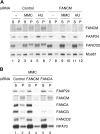Cell cycle-dependent chromatin loading of the Fanconi anemia core complex by FANCM/FAAP24
- PMID: 18174376
- PMCID: PMC2384144
- DOI: 10.1182/blood-2007-09-113092
Cell cycle-dependent chromatin loading of the Fanconi anemia core complex by FANCM/FAAP24
Abstract
Fanconi anemia (FA) is a genetic disease characterized by congenital abnormalities, bone marrow failure, and cancer susceptibility. A total of 13 FA proteins are involved in regulating genome surveillance and chromosomal stability. The FA core complex, consisting of 8 FA proteins (A/B/C/E/F/G/L/M), is essential for the monoubiquitination of FANCD2 and FANCI. FANCM is a human ortholog of the archaeal DNA repair protein Hef, and it contains a DEAH helicase and a nuclease domain. Here, we examined the effect of FANCM expression on the integrity and localization of the FA core complex. FANCM was exclusively localized to chromatin fractions and underwent cell cycle-dependent phosphorylation and dephosphorylation. FANCM-depleted HeLa cells had an intact FA core complex but were defective in chromatin localization of the complex. Moreover, depletion of the FANCM binding partner, FAAP24, disrupted the chromatin association of FANCM and destabilized FANCM, leading to defective recruitment of the FA core complex to chromatin. Our results suggest that FANCM is an anchor required for recruitment of the FA core complex to chromatin, and that the FANCM/FAAP24 interaction is essential for this chromatin-loading activity. Dysregulated loading of the FA core complex accounts, at least in part, for the characteristic cellular and developmental abnormalities in FA.
Figures







Comment in
-
FA core complex moves to chromatin.Blood. 2008 May 15;111(10):4837-8. doi: 10.1182/blood-2008-01-134668. Blood. 2008. PMID: 18467605
References
-
- Grompe M, van de Vrugt H. The Fanconi family adds a fraternal twin. Dev Cell. 2007;12:661–662. - PubMed
-
- Medhurst AL, Huber PA, Waisfisz Q, de Winter JP, Mathew CG. Direct interactions of the five known Fanconi anaemia proteins suggest a common functional pathway. Hum Mol Genet. 2001;10:423–429. - PubMed
-
- Meetei AR, de Winter JP, Medhurst AL, et al. A novel ubiquitin ligase is deficient in Fanconi anemia. Nat Genet. 2003;35:165–170. - PubMed
Publication types
MeSH terms
Substances
Grants and funding
LinkOut - more resources
Full Text Sources
Other Literature Sources
Molecular Biology Databases
Miscellaneous

